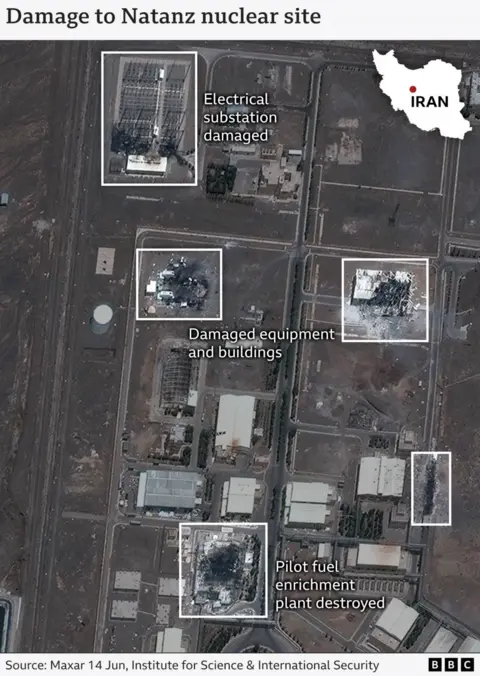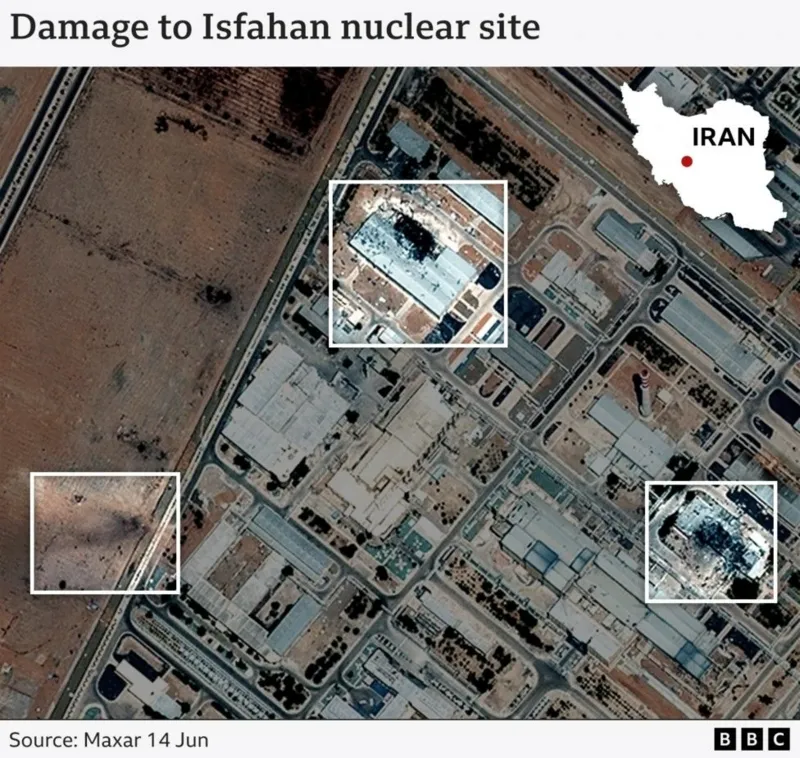BBC News
 Reuters
ReutersThe head of the global nuclear watchdog says there has been no further damage to Iran’s Natanz uranium enrichment plant since Israel struck the country’s nuclear sites on Friday.
Rafael Grossi told the International Atomic Energy Agency’s (IAEA) board of governors that an above-ground enrichment facility at Natanz was destroyed, but that there were no signs of a physical attack at the underground facility there.
Four buildings were also damaged at the Isfahan site, he said, including a uranium conversion plant, and no damage was visible at the underground Fordo enrichment plant.
Israel said it attacked the sites and killed nine nuclear scientists to stop Iran developing nuclear weapons.
It alleged that Iran had in recent months “taken steps to weaponize” its stockpile of enriched uranium, which can be used to make fuel for power plants but also nuclear bombs.
On Sunday, Iran reiterated that its nuclear programme was peaceful and urged IAEA’s 35-nation board to strongly condemn the Israeli strikes.
Grossi briefed the board on Monday that the IAEA had been monitoring the situation in Iran very carefully, ascertaining the status of the country’s nuclear facilities and assessing radiation levels through communication with local authorities.
He said Friday’s attack on Natanz destroyed the above-ground part of the Pilot Fuel Enrichment Plant (PFEP), where cascades of centrifuge were producing uranium enriched up to 60% purity – close to the 90% required for weapons-grade uranium
Electricity infrastructure at Natanz, which included an electrical sub-station, a power supply building, and emergency generators, were also destroyed.
“There has been no indication of a physical attack on the underground cascade hall containing part of the PFEP and the main Fuel Enrichment Plant. However, the loss of power to the cascade hall may have damaged the centrifuges there,” Grossi added.
He also said there was radiological and chemical contamination at the site, but that the level of radioactivity outside had remained unchanged and at normal levels.
The Israeli military said on Friday that the underground centrifuge hall was also damaged as part of the attack on Natanz, but it provided no evidence.

The IAEA chief said four buildings were damaged in a separate attack on Friday on the Isfahan Nuclear Technology Centre – the central chemical laboratory, a uranium conversion plant, the Tehran reactor fuel manufacturing plant, and a facility to convert uranium hexafluoride to uranium metal, which was under construction.
As at Natanz, off-site radiation levels remain unchanged, he added.
The Israeli military said on Friday that the Isfahan strike “dismantled a facility for producing metallic uranium, infrastructure for reconverting enriched uranium, laboratories, and additional infrastructure”.

On Saturday, Iran’s semi-official Isna news agency quoted spokesman of the Atomic Energy Organization of Iran (AEOI) as saying there was “limited damage to some areas at the Fordo enrichment site” following an Israeli attack.
However, the Israeli military has not confirmed carrying out any strikes there.
Grossi said no damage had been seen at Fordo, or at the Khondab heavy water reactor, which is under construction.
He urged all parties to exercise maximum restraint, warning that military escalation threatened lives and increased the chance of a radiological release with serious consequences for people and the environment.
Iranian Foreign Minister Abbas Araghchi told foreign diplomats in Tehran on Saturday that Israel’s attacks on his country’s nuclear facilities were a “blatant violation of international law”, and that he hoped the IAEA’s board would issue a strong condemnation.
He also said that Iran’s missile strikes on Israel since Friday were a “response to aggression”.
The Israeli military’s spokesperson, Brig Gen Effie Defrin said on Monday that its large-scale air campaign would “continue to act in pursuit of the operation’s objective, to neutralize the existential threat from Iran, from its nuclear project to the regime’s missile array”.
Iran’s health ministry says Israeli strikes have killed more than 220 people since Friday. Twenty-four Israelis have been killed by Iranian missiles, according to Israeli authorities.
Last Thursday, the IAEA’s board formally declared Iran in breach of its non-proliferation obligations for the first time in 20 years. A resolution said Iran’s “many failures” to provide the agency with full answers about its undeclared nuclear material and nuclear activities constituted non-compliance.
Under a 2015 nuclear deal with world powers, Iran was not permitted to enrich uranium above 3.67% purity – the level required for fuel for commercial nuclear power plants – and was not allowed to carry out any enrichment at Fordo for 15 years.
However, US President Donald Trump abandoned the agreement during his first term in 2018, saying it did too little to stop a pathway to a bomb, and reinstated US sanctions.
Iran retaliated by increasingly breaching the restrictions – particularly those relating to enrichment. It resumed enrichment at Fordo in 2021 and has amassed enough 60%-enriched uranium to potentially make nine nuclear bombs, according to the IAEA.




